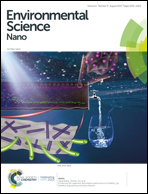Long-term sediment exposure to ZnO nanoparticles induces oxidative stress in Caenorhabditis elegans†
Abstract
Concerns have arisen regarding potential environmental risks from the increased usage and widespread development of engineered nanomaterials (ENMs). Zinc oxide nanoparticles (ZnO-NPs) are emerging materials that tend to accumulate in sediment after being released into aquatic environments, potentially leading to chronic toxicity in aquatic ecosystems. In this study, the nematode Caenorhabditis elegans was used to evaluate the chronic toxicity of ZnO-NPs in sediment and the underlying molecular mechanisms. Following long-term sediment exposure to ZnO-NPs, growth and reproduction defects were not observed in C. elegans at the examined concentrations, whereas locomotive behaviours (frequency of body bends and head thrashes) and ATP levels were adversely affected. In addition, significant increases in intracellular reactive oxygen species and lipid peroxidation were induced by long-term sediment exposure to ZnO-NPs. Furthermore, long-term sediment exposure to ZnO-NPs triggered translocation of the transcription factor DAF-16/FOXO from the cytoplasm to the nuclei and further activated the targeted expression of the corresponding stress-responsive genes (mtl-1 and sod-3). This study demonstrates that long-term sediment exposure to ZnO-NPs results in oxidative stress in the benthic organism C. elegans, mediated by the transcription factor DAF-16 triggering stress-responsive gene activation.



 Please wait while we load your content...
Please wait while we load your content...